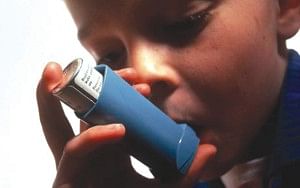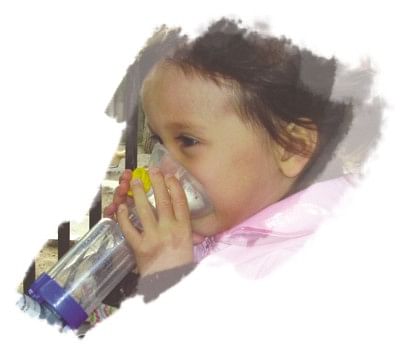|
Health
UNDERSTANDING ASTHMA IN CHILDREN
PROFESSOR MD SIRAJUL ISLAM
 There are a number of conditions in which children develop wheezing, ronchi and crepitations in the lungs starting from bronchiolitis in early infancy to recurrent attacks of wheezing in elderly children. Children suffering from pneumonia may also suffer from wheezing of various degrees. Mothers of infants and children will generally recognise these manifestations as asthma. If asked, mothers instead of describing the symptoms will rather say that her child is suffering from asthma. Mothers are not themselves responsible for thinking this way, rather in many a cases it is because of some casual remark of the medical professionals that the child has developed asthma without thinking of the stigma associated with this illness. To a great extent, these wheezing infants and children become symptom free in time and the wheezing will rarely recur in their life time again as they grow older. There are a number of conditions in which children develop wheezing, ronchi and crepitations in the lungs starting from bronchiolitis in early infancy to recurrent attacks of wheezing in elderly children. Children suffering from pneumonia may also suffer from wheezing of various degrees. Mothers of infants and children will generally recognise these manifestations as asthma. If asked, mothers instead of describing the symptoms will rather say that her child is suffering from asthma. Mothers are not themselves responsible for thinking this way, rather in many a cases it is because of some casual remark of the medical professionals that the child has developed asthma without thinking of the stigma associated with this illness. To a great extent, these wheezing infants and children become symptom free in time and the wheezing will rarely recur in their life time again as they grow older.
Occasional wheezing is not enough to call a child asthmatic. Asthma is a chronic lung disease characterised by recurrent cough and wheezing. It is found more often in patients with a personal or family history of atopy, a situation characterised by frequent sneezing and runny nose more often in a dusty environment. Family history of asthma and allergic conditions are strongly supportive of a diagnosis in favour of asthma. To be more precise, children with recurrent cough, wheezing, chest tightness or shortness of breath may have one or more forms of asthma. It leads to a situation of a chronic inflammatory disorder of the airways within the lungs.
Diagnosing the precise cause of asthma is sometimes difficult because two or more causes may be present in one child. Unfortunately, there is not a single test that provides all the answers. How often episodes of wheezing, coughing or other symptoms occur and the intensity of these symptoms are important to understand before a child is labelled as asthmatic. To understand the cause of wheezing and associated manifestations, it is also important to recognise what triggers the symptoms. Smoking and pets in the house may often be the triggering factors of wheezing and breathing difficulty. Infants need extra attention during the diagnostic process because asthma symptoms can be caused by many things in this age group, some of which need very different therapies. When an infant or child has asthma symptoms, it is sometimes called "reactive airway disease" rather than straight way labelling the infant or child as asthmatic.
 An attack of wheezing occurs when the airways of the lungs become narrowed and the muscles around them tightly contract leading to a situation called bronchospasm. The membranes lining the inner walls of the airways become swollen and inflamed, and the glands within these walls produce excess mucus. The two most common triggers of asthma in children are colds and allergens. Avoiding the allergens to which the child is allergic may help improve his or her asthma. The most common allergen source is house dust mites. Other significant allergens are tree pollens, cockroaches and spores of common moulds. In Bangladesh situation, where constructions are taking place almost everywhere in the cities, dust and carbon emissions from vehicles and brickfields are potential source of triggering asthma symptoms. And those who have a clear history of allergy or atopy should very well avoid hilsha fish, prawns, beef, duck eggs and brinjal. Clinical experience clearly indicates the rise of symptoms like wheezing, ronchi and breathing difficulty in Bangladesh although due to lack of epidemiological studies, the exact situation of prevalence of childhood asthma cannot be spelled out. Not less than 16 percent of children, however, develop wheezing during childhood under five years. But data from the US show increasing prevalence of asthma among children. More than 5 percent of the U.S. population younger than 18 years, nearly 5 million children is affected by this disorder. Managing childhood asthma involves treatment with current drugs and procedural devices. Education and support of the child and his family for longer-term management are also needed. Transient early wheezers precipitated commonly by viral upper respiratory infections will most likely be symptom free by about three years, particularly children without a family or personal history of atopy or allergy. Non-atopic wheezers again are likely to outgrow symptoms by an early school age. Sometimes the symptoms may reappear less frequently till 10 to 12 years of age, but usually these children become symptom free unless they or their family members have a history of atopy, eczema or allergy. However, children who go on to develop a more persistent, atopic asthma, associated with raised immunoglobulin E (IgE) levels may need to be cared for full blown asthmatic conditions. An attack of wheezing occurs when the airways of the lungs become narrowed and the muscles around them tightly contract leading to a situation called bronchospasm. The membranes lining the inner walls of the airways become swollen and inflamed, and the glands within these walls produce excess mucus. The two most common triggers of asthma in children are colds and allergens. Avoiding the allergens to which the child is allergic may help improve his or her asthma. The most common allergen source is house dust mites. Other significant allergens are tree pollens, cockroaches and spores of common moulds. In Bangladesh situation, where constructions are taking place almost everywhere in the cities, dust and carbon emissions from vehicles and brickfields are potential source of triggering asthma symptoms. And those who have a clear history of allergy or atopy should very well avoid hilsha fish, prawns, beef, duck eggs and brinjal. Clinical experience clearly indicates the rise of symptoms like wheezing, ronchi and breathing difficulty in Bangladesh although due to lack of epidemiological studies, the exact situation of prevalence of childhood asthma cannot be spelled out. Not less than 16 percent of children, however, develop wheezing during childhood under five years. But data from the US show increasing prevalence of asthma among children. More than 5 percent of the U.S. population younger than 18 years, nearly 5 million children is affected by this disorder. Managing childhood asthma involves treatment with current drugs and procedural devices. Education and support of the child and his family for longer-term management are also needed. Transient early wheezers precipitated commonly by viral upper respiratory infections will most likely be symptom free by about three years, particularly children without a family or personal history of atopy or allergy. Non-atopic wheezers again are likely to outgrow symptoms by an early school age. Sometimes the symptoms may reappear less frequently till 10 to 12 years of age, but usually these children become symptom free unless they or their family members have a history of atopy, eczema or allergy. However, children who go on to develop a more persistent, atopic asthma, associated with raised immunoglobulin E (IgE) levels may need to be cared for full blown asthmatic conditions.
Treatment ranges from giving oxygen in acute conditions and commonly used drugs like beta2 agnostics like solbutamol and terbutaline which may be given orally or with the help of spacers and nebuliser. Ipratropium bromide is another drug used as nebuliser in early infancy and the elderly. Short-term use of steroids in acute asthmatic attacks is a common practice. However, steroids with fewer side effects may also be recommended for long term use as inhalers or evohalers in asthmatic conditions, which tend to be persistent. With more research and trial, drugs which are better tolerated and yet have a good control over the wheezing situations are being increasingly available and management of wheezing conditions or asthma can be done easily these days much to the comfort of children and their parents.
Dr Md Sirajul Islam is Director, Holy Family Red Crescent Medical College and Hospital.
Copyright
(R) thedailystar.net 2010 |
| |
